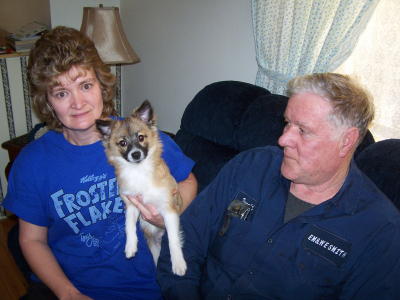| ORMA COUPLE BARELY ESCAPE CARBON MONOXIDE DEATH - Family Dog Is Hero, "We're Glad To Be Alive"
The Herald republishes this story as a warning to residents about the danger of carbon monoxide and the importance of workable detectors.

Kathy and Ronnie Summers are "Glad to be alive," with a
heroic assist from Sparky, who "was rescued from death at
the Roane County Animal Shelter, and has now rescued us"
By Bob Weaver 01/22/09
An Orma family narrowly escaped death from carbon monoxide fumes last week, thanks to the attention of their miniature collie.
Ronnie and Kathy Summers were overcome early Saturday morning by odorless fumes coming from a basement furnace and heater.
Battery operated carbon monoxide detectors failed to give an alarm, they said.
Both passed out under the influence of the fumes, later determined to be 600 ppm in the house, considered deadly by experts.
"You know something really bad is happening, but you just can't connect the dots and rescue yourself. My head was really hurting," said Kathy, who was unconscious more than once before Calhoun EMS arrived.
She managed to be alert enough to get to a bedroom to check on her husband, who was sprawled on his back across the bed, unresponsive and making "loud groaning noises, clammy and sweaty."
"I knew something was really wrong with him, like a heart attack or stroke," she said, going to the phone and calling her son, with intentions of asking for help.
She then passed out, falling to the floor.
Lying face down, she got some fresher air, got up again and managed to call 911. "I told the dispatcher my name and fell back to the floor in the bathroom," not remembering talking on the phone.
With minimal information, dispatcher Fred Waybright managed to locate the residence and send an ambulance about 2 a.m.
The real hero in the story was the family dog Sparky, who barked and tugged on the pant-leg of Ronnie Summers, arousing him.
"I crawled to the bathroom to discover Kathy," he said, then drug her to the kitchen, opening an outside window and door.
"I just couldn't think straight," said Ronnie.
Coming to again, Kathy said she had an hallucination that a bear was trying to get into the house. She closed the air-breathing door, locked it and somehow managed to get to the basement to hide.
"It was the worst place I could have gone," she said.
"I was confused and hiding in the basement when Calhoun EMS arrived," she said. "They started throwing all the windows open after Ronnie unlocked the door."
The couple was administered emergency care and oxygen and taken to the hospital.
"It takes a few days for the carbon monoxide to leave the system," Kathy said.
"We're fortunate to be alive. If Sparky hadn't done what he did, we wouldn't have made it."
She said homeowners should avoid cheap battery operated monoxide detectors. "You should place the detectors near the heat source," she concluded, "I hope people will be more aware of this problem."
CARBON MONOXIDE INFORMATION
What is carbon monoxide?
Carbon monoxide or CO is a colorless, odorless and tasteless gas.
Due to this fact, it is very hard to detect the presence of CO.
It is imperative that the CO levels in your home are carefully monitored.
Even at relatively low levels, CO is poisonous because it rapidly accumulates in the blood, depleting its ability to carry oxygen.
Extreme cases of CO poisoning result in death.
Where does carbon monoxide come from?
CO is a common by-product of the combustion of fossil fuels.
When properly installed and maintained, most fuel burning equipment (natural gas, propane or oil) will produce insignificant amounts of CO.
At what level does carbon monoxide become toxic?
For healthy adults, CO becomes toxic when it reaches a level higher than 50 ppm (parts per million) with continuous exposure over an eight hour period.
When the level of CO becomes higher than that, a person will suffer from symptoms of exposure.
Mild exposure over a few hours (a CO level between 70 ppm and 100 ppm) include flu-like symptoms such as headaches, sore eyes and a runny nose.
Medium exposure (a CO level between 150 ppm to 300 ppm) will produce dizziness, drowsiness and vomiting.
Extreme exposure (a CO level of 400 ppm and higher) will result in unconsciousness, brain damage and death.
How to avoid carbon monoxide poisoning
- have a qualified technician install and regularly inspect all fuel burning appliances
- regularly inspect fireplaces and chimneys to insure proper ventilation
- never use a gas or charcoal barbecue indoors
- never start a car or gas run lawn mower or snow blower in a closed garage
- install carbon monoxide detectors in your home.
| 


